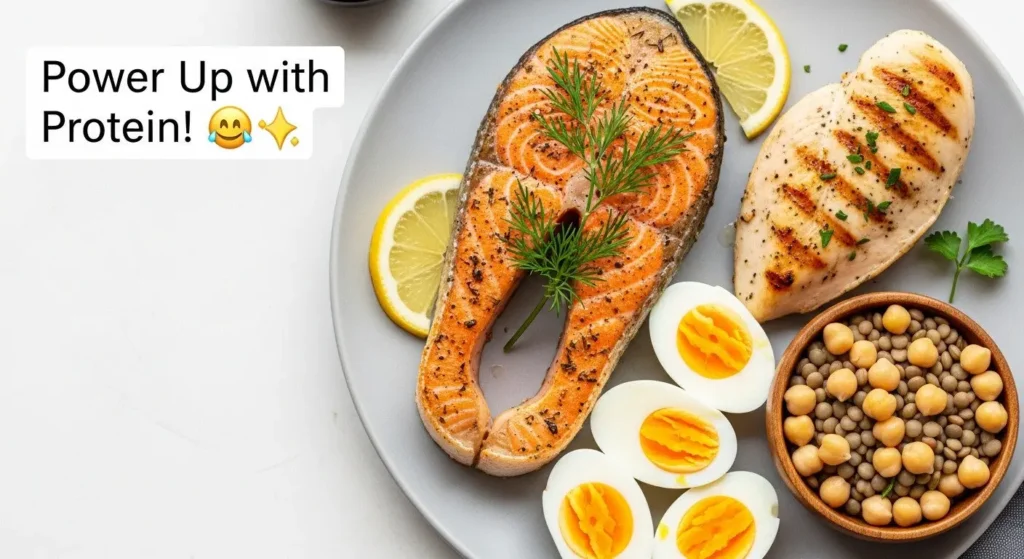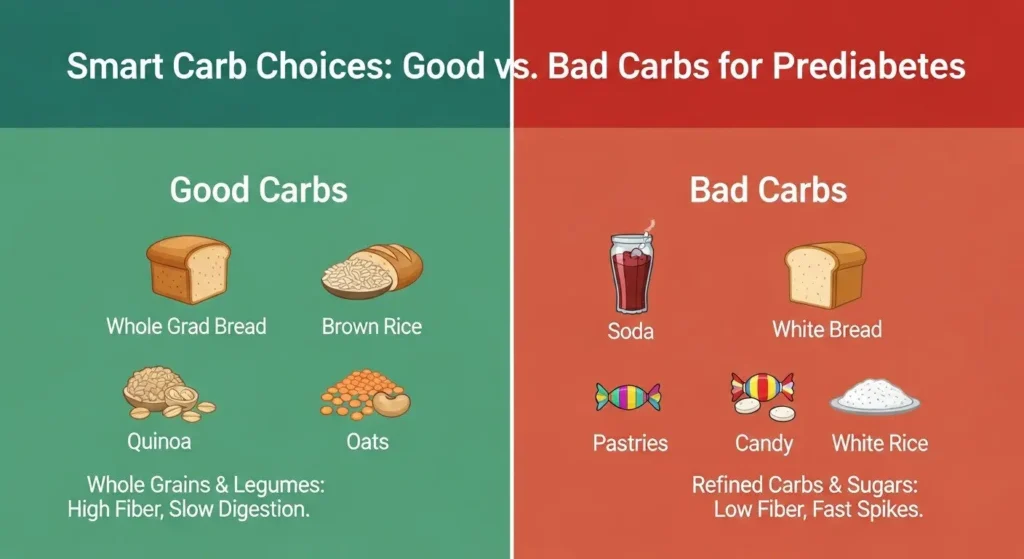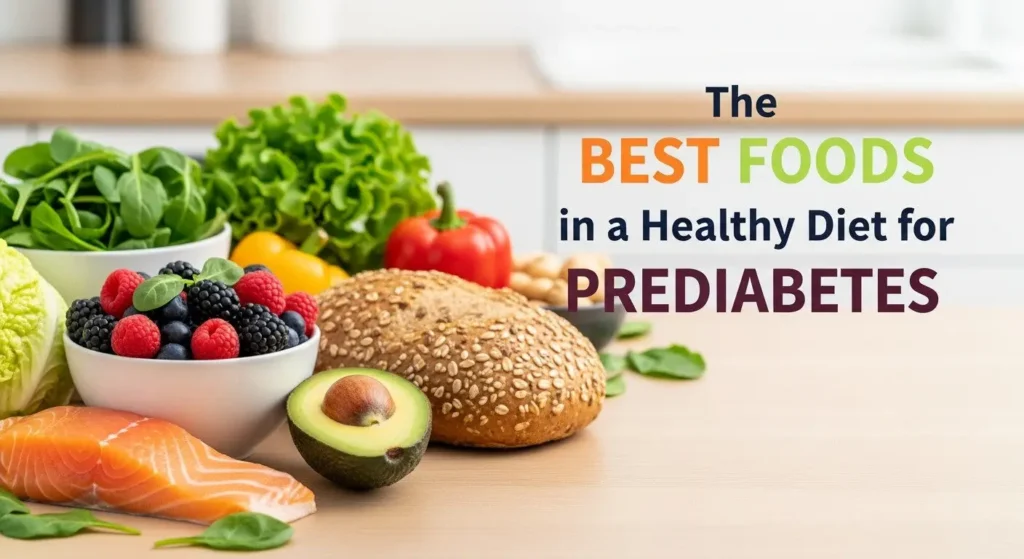Feeling a little confused about what to eat when you're told you have prediabetes? You're not alone! Prediabetes means your blood sugar levels are higher than normal, but not yet high enough to be called type 2 diabetes. Think of it as a warning sign, a chance to make some changes and get back on track. The good news? Following a healthy diet for prediabetes is one of the most powerful steps you can take to prevent full-blown diabetes.

This article will walk you through the best foods to include in your daily meals, helping you understand how to build a healthy diet for prediabetes. We'll explore tasty options that keep your blood sugar steady and boost your overall health. Let's dig in!
Prediabetes-Friendly Food Checker
Type a food item to see if it's generally recommended for a prediabetes diet.
Key Takeaways
- Focus on Whole Foods: Prioritize unprocessed foods like fresh vegetables, fruits, whole grains, lean proteins, and healthy fats.
- Control Carbohydrates: Choose complex carbs (like whole grains) over simple carbs (like sugary drinks), and be mindful of portion sizes.
- Embrace Fiber: High-fiber foods help slow sugar absorption, keeping blood sugar levels stable and making you feel full.
- Limit Sugars & Processed Foods: Cut back on sugary drinks, sweets, white bread, and fast food, which can cause rapid blood sugar spikes.
- Stay Hydrated & Active: Drinking plenty of water and staying active are essential components of a healthy diet for prediabetes.
Understanding Healthy Diet For Prediabetes: Why Diet Matters So Much
Imagine your body as a car, and sugar (glucose) as its fuel. Insulin is like the key that opens the car's doors, allowing the fuel to get inside and be used for energy. When you have prediabetes, your body might not make enough insulin, or your cells might not respond well to the insulin it does make. This is called insulin resistance. When cells resist insulin, sugar builds up in your blood instead of going into your cells, leading to high blood sugar.
The good news is that prediabetes is often reversible! Making changes to your diet and lifestyle can significantly lower your blood sugar levels and prevent type 2 diabetes. In fact, studies show that lifestyle changes are often more effective than medication in preventing diabetes for people with prediabetes. It's about giving your body the right tools to work better.
💡 Did You Know? Losing just 5-7% of your body weight can significantly reduce your risk of developing type 2 diabetes if you have prediabetes! For someone weighing 200 pounds, that's only 10-14 pounds.
The Foundation of a Healthy Diet for Prediabetes
A healthy diet for prediabetes isn't about strict deprivation; it's about smart swaps and embracing nutritious, whole foods. The goal is to choose foods that help keep your blood sugar levels steady, provide lasting energy, and support a healthy weight.
Here are the cornerstones of a healthy diet for prediabetes eating plan:

1. Colorful Vegetables
Vegetables are your best friends! They are packed with vitamins, minerals, and fiber, but are low in calories and carbohydrates. This means they won't cause big spikes in your blood sugar.
Best Choices:
- Leafy Greens: Spinach, kale, Swiss chard, romaine lettuce. Add them to smoothies, salads, or sauté them.
- Cruciferous Veggies: Broccoli, cauliflower, Brussels sprouts, cabbage. Great roasted, steamed, or stir-fried.
- Bell Peppers: All colors! Full of Vitamin C.
- Cucumbers, Zucchini, Tomatoes: Hydrating and versatile.
- Asparagus, Green Beans, Mushrooms: Excellent low-carb options.
How to Enjoy More Veggies:
- Fill half your plate with non-starchy vegetables at every meal.
- Snack on veggie sticks with hummus.
- Add extra veggies to soups, stews, and casseroles.
- Try a veggie-packed omelet for breakfast.
2. Fiber-Rich Fruits
While fruits contain natural sugars, they also provide essential vitamins, antioxidants, and most importantly, fiber. Fiber helps slow down the absorption of sugar into your bloodstream, preventing rapid spikes. Focus on whole fruits rather than juices, which lack fiber.
Best Choices (in moderation):
- Berries: Strawberries, blueberries, raspberries, blackberries. They are lower in sugar and high in antioxidants.
- Apples: With the skin on for maximum fiber.
- Pears: Another good source of fiber.
- Citrus Fruits: Oranges, grapefruits (check for medication interactions), lemons, limes.
- Cherries: Low glycemic index.
Fruits to Limit (due to higher sugar content): Mangoes, bananas, grapes, pineapple. Enjoy these in smaller portions.
3. Whole Grains & Legumes
Whole grains keep their entire grain kernel, including the bran, germ, and endosperm. This means they have more fiber and nutrients compared to refined grains (like white bread or white rice). Legumes (beans, lentils) are also excellent sources of fiber and plant-based protein.
Best Choices:
- Oats: Rolled oats or steel-cut oats for breakfast.
- Quinoa: A complete protein and versatile grain.
- Brown Rice/Wild Rice: Healthier alternatives to white rice.
- Whole-Wheat Bread/Pasta: Look for “100% whole wheat” on the label.
- Barley, Farro: Great for adding to soups and salads.
- Lentils: Red, green, or brown lentils for soups, stews, or salads.
- Black Beans, Kidney Beans, Chickpeas: Excellent in chili, tacos, or roasted as a snack.
Why they're good: The fiber in whole grains and legumes helps you feel full longer, aids digestion, and prevents blood sugar from rising too quickly.

4. Lean Proteins
Protein helps stabilize blood sugar by slowing down digestion and preventing sharp spikes. It also helps you feel full and satisfied, which can aid in weight management.
Best Choices:
- Fish: Salmon, tuna, mackerel, sardines (rich in omega-3 fatty acids). Aim for at least two servings a week.
- Poultry: Skinless chicken breast, turkey.
- Eggs: A versatile and complete protein.
- Lean Beef/Pork: Choose lean cuts and trim visible fat.
- Plant-Based Proteins: Tofu, tempeh, edamame, lentils, beans, nuts, seeds.
Tip: Combine protein with carbohydrates at meals to help slow down sugar absorption. For instance, instead of just an apple, have an apple with a handful of almonds.
5. Healthy Fats
Don't fear fats! Healthy fats are essential for overall health, can help you feel full, and don't directly raise blood sugar levels. They can also improve insulin sensitivity over time.
Best Choices:
- Avocado: Creamy and full of monounsaturated fats.
- Nuts: Almonds, walnuts, pistachios, pecans (in moderation due to calorie density).
- Seeds: Chia seeds, flax seeds, pumpkin seeds, sunflower seeds.
- Olive Oil: Extra virgin olive oil for cooking and dressings.
- Fatty Fish: Salmon, mackerel (as mentioned above).
Fats to Limit: Trans fats (found in many processed snacks and fried foods) and excessive saturated fats (found in fatty meats, butter, full-fat dairy).

Foods to Limit or Avoid
To maintain a healthy diet for prediabetes, it's just as important to know which foods to limit or avoid as it is to know what to eat. These foods tend to be high in refined sugars, unhealthy fats, and processed carbohydrates, which can cause rapid blood sugar spikes and contribute to weight gain.
- Sugary Drinks: Soda, fruit juices (even 100% juice), sweetened teas, energy drinks. These are like a direct sugar shot to your bloodstream. Choose water, unsweetened tea, or sparkling water with a squeeze of lemon instead.
- Refined Grains: White bread, white rice, pasta made from white flour, pastries, cakes, cookies. These lack fiber and are quickly converted to sugar.
- Processed Snacks: Chips, crackers, most breakfast cereals (check labels!), candy bars. They often contain hidden sugars, unhealthy fats, and refined carbs.
- Fried Foods & Fast Food: High in unhealthy fats and often refined carbohydrates.
- Sweetened Dairy Products: Flavored yogurts, ice cream. Opt for plain Greek yogurt and add your own berries.
- Excessive Red & Processed Meats: While protein is good, too much red meat (especially fatty cuts) and processed meats (bacon, sausage, deli meats) can be linked to insulin resistance.
Crafting Your Prediabetes-Friendly Meal Plan
Putting it all together can seem daunting, but it's really about balance and consistency. Here’s a sample day to inspire your healthy diet for prediabetes:
| Meal | Example Foods | Why It Works |
|---|---|---|
| Breakfast | Scrambled eggs with spinach and mushrooms, a slice of 100% whole-wheat toast with a thin layer of avocado. | Protein from eggs and healthy fat from avocado keep you full and stabilize blood sugar. Fiber from spinach and whole-wheat toast adds nutrients without a big sugar spike. |
| Snack | An apple with a small handful of almonds. | Fiber from the apple and protein/healthy fats from almonds provide sustained energy and prevent hunger pangs before lunch. |
| Lunch | Large salad with mixed greens, grilled chicken or chickpeas, cucumber, bell peppers, cherry tomatoes, and a light vinaigrette dressing. | Packed with non-starchy vegetables and lean protein, this meal is low in calories but high in nutrients and fiber, promoting stable blood sugar. |
| Snack | Plain Greek yogurt with a few berries. | Greek yogurt offers protein and probiotics. Berries add natural sweetness and antioxidants without a lot of sugar. |
| Dinner | Baked salmon, a generous serving of steamed broccoli, and a small portion of quinoa or brown rice. | Salmon provides healthy omega-3 fats and lean protein. Broccoli is a fiber-rich, low-carb vegetable. Whole grain (quinoa/brown rice) offers complex carbs for energy without a rapid blood sugar rise. |
| Hydration | Throughout the day: Water, unsweetened herbal tea. | Staying hydrated is crucial for overall health and can help your body function better, including regulating blood sugar. |
Always remember to check portion sizes! Even healthy foods can impact blood sugar if eaten in very large amounts.
Beyond the Plate: Lifestyle Factors for Prediabetes Management
While diet is a huge part of managing prediabetes, following a healthy diet for prediabetes alongside other lifestyle choices is equally important.
- Regular Physical Activity: Aim for at least 150 minutes of moderate-intensity exercise per week. This could be brisk walking, swimming, cycling, or dancing. Exercise helps your body use insulin more effectively and can aid in weight loss. Every little bit helps!
- Weight Management: If you are higher weight, losing even a small amount of weight can make a big difference in improving your blood sugar levels. A balanced diet combined with regular exercise is the most sustainable way to achieve this. For those looking for strategies, exploring options like a 3-day fast for weight loss or understanding Liv Pure reviews could offer additional perspectives on weight management, always under professional guidance.
- Stress Management: Stress can affect blood sugar levels. Find healthy ways to cope, such as meditation, yoga, hobbies, or spending time in nature.
- Adequate Sleep: Lack of sleep can impact insulin sensitivity. Aim for 7-9 hours of quality sleep per night.
- Regular Check-ups: Keep up with your doctor's appointments to monitor your blood sugar levels and discuss your progress.
Remember, managing your health is a holistic journey. While following a healthy diet for prediabetes is paramount, considering other aspects of your well-being, such as general health supplements, can be part of a broader health strategy. For example, men often look into options like prostate supplements to support specific health areas. If you're exploring such options, it's wise to review the most effective prostate supplements or learn about specific products like Prostavive for tackling prostate problems. Always consult with a healthcare professional before adding any new supplements to your routine.
Making It Stick: Tips for Long-Term Success
Changing your eating habits takes time and effort. Here are some tips to help you stick to a healthy diet for prediabetes:
- Plan Ahead: Meal prepping or planning your meals for the week can prevent last-minute unhealthy choices.
- Read Food Labels: Pay attention to serving sizes, total carbohydrates, added sugars, and fiber content.
- Cook at Home: This gives you full control over ingredients.
- Don't Be Afraid to Experiment: Try new healthy recipes and ingredients to keep things interesting.
- Find a Support System: Share your goals with family and friends, or join a support group.
- Be Patient and Kind to Yourself: There will be days when you slip up. Don't give up! Just get back on track with your next meal.
- Consult a Professional: A registered dietitian or certified diabetes educator can provide personalized advice and support.
Conclusion
Taking control of your diet is the most powerful step in managing prediabetes. Following a healthy diet for prediabetes that emphasizes whole, unprocessed foods—colorful vegetables, fiber-rich fruits, whole grains, lean proteins, and healthy fats—can stabilize blood sugar, support weight management, and boost energy levels.
It's not about being perfect, but about making consistent, positive choices. Every healthy meal is a step towards a healthier, happier you. Start small, make gradual changes, and celebrate your progress. Your body will thank you!








